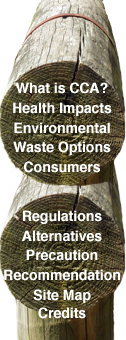Precautionary Principle
The CC review by the Australian Pesticides and Veterinary Medicines Authority (APVMA) found there was ‘insufficient information to conclude that it is safe to continue the use of arsenic treatments for timber in structures that children are likely to have frequent close contact with’, and thus recommended a ‘highly protective approach’ that ‘these uses no longer be permitted’ (APVMA, 2003c).
In particular the APVMA noted the lack of Australian data regarding arsenic-related playground exposure. It stated that there was a ‘very limited amount of Australian data to quantify the amount of arsenic which can transfer or leach from in-service CCA-treated timber structures’. It claimed that international studies may not correlate with Australia’s ‘local climatic conditions’. Actually Australian conditions may be worse because of the warmer climate. The APVMA also noted that Australians are exposed to arsenic in various ways, aside from CCA-treated timber, and ‘the data available for the review were not sufficient’ to decide whether Australian children would transfer so much arsenic to their mouths, whilst playing on treated timber play equipment, that their health would be impacted (APVMA, 2003a: 8).
The APVMA concluded that there was ‘no compelling evidence … to conclude that there was likely to be an unacceptable risk to public health from exposure to arsenic from CCA-treated timber’ (APVMA, 2003b, p.25). Nevertheless, it could not ‘be satisfied that there is no undue risk from the continuing use of products containing CCA… with which the public are likely to come into frequent contact’. The APVMA therefore decided it was necessary to prohibit CCA-treated timber from being used on products ‘with which members of the public are likely to come into intimate and frequent contact’, including play equipment, decking, picnic tables and handrails (APVMA, 2003a: 8).
The APVMA’s action is a good example of the exercise of the precautionary principle, which states:
When an activity raises threats of harm to human health or the environment, precautionary measures should be taken even if cause and effect relationships are not fully established scientifically (Wingspread Statement on the Precautionary Principle, 1998).
This means that although further independent research is required that involves a large sample size, under Australian conditions, the lack of data should not be used as an excuse to do nothing about CCA-treated timber, because there is scientific evidence that it may pose a harm to human health.
The APVMA does not use the term ‘precautionary’ and is loath to have its actions labelled in this way. This can best be understood in terms of the international chemical industry’s campaign to discredit the term because of fears that it will lead to the banning of some of its products. Nevertheless, the precautionary principle is well established in Europe and is evolving into a principle of international law. In recent times it has been included in almost all treaties and international policy documents, and has been into environmental law in many countries, including Australia (Andorno, 2004).
The APVMA has not applied the precautionary principle to existing CCA-treated timber structures already in the community, particularly play equipment, picnic tables and decking. Instead the APVMA clearly stated that, ‘while there is not enough scientific evidence to meet the high standard of confidence necessary to confirm the safety of ongoing use of CCA for the treatment of timber in applications such as decks and play equipment’, they do not suggest that existing structures are removed (APVMA, 2003b).
Existing structures, that is, in-service treated timber, pose the same risks as proposed uses. The APVMA stance is therefore contradictory: why is future CCA-treated timber use a problem, but not current or spent timber? (Immig, J., APVMA Community Consultative Committee, Pers. Comm., 22/11/04).
References:
Andorno, R. (2004), ‘The precautionary principle: a new legal standard for a technological age’, Journal of International Biotechnology Law 1, pp. 11-19.
APVMA (2003a), The Reconsideration Of Registrations Of Arsenic Timber Treatment Products (CCA And Arsenic Trioxide) And Their Associated Labels (Review Summary), Australian Pesticides And Veterinary Medicines Authority, Canberra (pdf - 1.2MB).
APVMA (2003b), The Reconsideration Of Registrations Of Arsenic Timber Treatment Products (CCA And Arsenic Trioxide) And Their Associated Labels (Technical Report), Australian Pesticides And Veterinary Medicines Authority, Canberra. (pdf - 4.5MB)
APVMA (2003c), Media Release - Draft Report on Arsenic Treated Timber Released for Public Comment, Australian Pesticides & Veterinary Medicines Authority, December 22, Canberra, http://www.apvma.gov.au/media/mr0310.shtml


